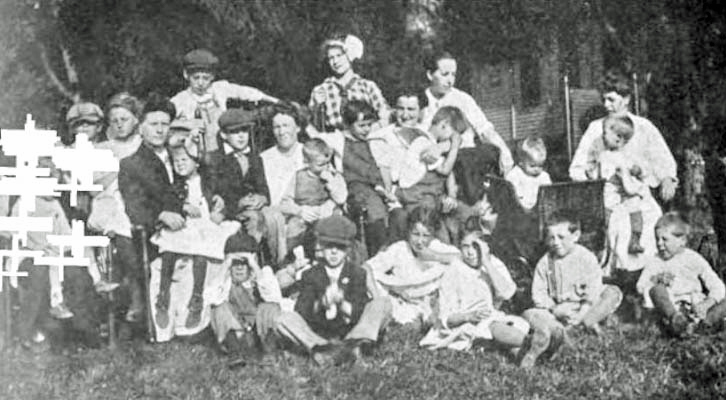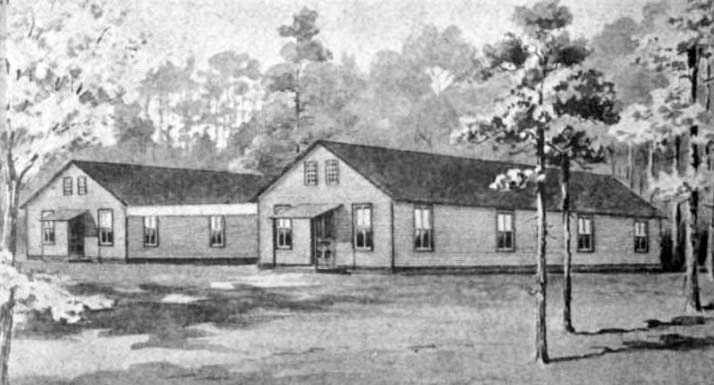True Tales from Canton’s Past: Salvation in Canton
By George T. ComeauThe widow Mary Sullivan had experienced a truly awful year. Just months earlier her husband had died, leaving her with six mouths to feed. Sadly, two of her children also died, leaving her in a filthy tenement building with four small children and a backdrop of desperation. It was June 1914, and Boston was teeming with the record number of poor and destitute immigrants. As many wealthy Bostonians were planning escapes from the impending heat, thousands of deprived children would never know the delights of a day in the countryside. But this would not be the case for Mary Sullivan’s children — she wanted them to be able to get away and distance themselves from the pain and loss they had experienced when their father and siblings had died. Mary wanted them to have a vacation.
Vacations for the poor were unheard of in the early 20th century. Life was defined by their ability to simply put food on the table and keep a roof overhead. And to bring comfort and aid, a variety of private organizations were formed. One of the best known was the Salvation Army, which began in Philadelphia in 1879 and within five years had begun to serve in Boston’s West End. They worked directly among the people to bring services and help improve, in small and simple ways, the lives of the most unfortunate members of society.
One such way was the creation of a summer camp in Canton. On June 22, 1914, mothers and their children from the hottest tenements in Boston gathered a few belongings and walked to South Station. There were 75 in all, 12 mothers and 63 children. One mother had eight small children, and three others had six each. Then there was the widow Mary Sullivan with her four children, fresh with the memory of the death of their father and their brother and sister. Each brother and sister held their little hands and Mary carried the baby. Boarding the train to Canton, she smiled bravely with the trust that this would be a wonderful escape.
They knew very little of their destination, other than the fact that they were going on a two-week holiday. As the special train left and Boston slipped away, the journey quickly became quite pleasant. Cool air rushed into the car, and the children all clamored for window seats to watch the world whiz by. In no time at all they arrived at Canton Junction. An array of small buses and trucks waited for them and soon they rattled up Chapman Street and took a small turn on Washington Street. At the corner of Dedham Street they took a left and proceeded to what was known as the Shepard Estate.
The Salvation Army had been looking for a place to build a summer camp as early as 1910. The land had to be accessible by train or a short walk from a station; there had to be rolling views and space enough to house hundreds of children and their mothers in sanitary and safe conditions. In January 1911 they found such a place — right here in Canton. In 1906, George and Mabel Burt sold 15 acres of land to the wealthy heir of the Shepard Norwell Company — a dry goods empire that had a long and storied New England history. Within a year of purchasing the property and building a large, impressive estate house, the land changed hands and was purchased by a Polish immigrant as a farmstead. The Shepard family seems to have held some interest, and were quite active supporters of the Salvation Army mission in Boston.
The Polish-Russian Stansilow Parpalowicz had come to America in 1900 as a farmer and he secured a loan to buy the 15 acres. For whatever reason, the farm did not do well enough for the large Polish family to stay, and they sold the property with a mortgage held by Martha Howard Draper to the Salvation Army in 1911.
As the children arrived that day in June, they were greeted by Major and Mrs. Joseph Shepard and ushered into the great house that served as the camp administration building. The dining room was thrown open and 80 people were served a bountiful lunch. Outside, a grove of larch, hemlock, spruce and pine trees opened up across a rolling vista that was punctuated by the Great Blue Hills. Four sleeping camps were arranged with well-ventilated tents, complete with “snowy” white cots and large comfortable beds for the mothers. The boys played baseball and the girls began using the swings and other lawn games. Free milk was given to children under 2 years of age and 150 babies were fed throughout the summer.
The camp had been established to maintain a country place that would give the “little sons and daughters of the poor and their work-weary mothers a complete change of atmosphere.” And to do so, more than a dozen buildings, including dormitories, a pavilion and dining hall, accommodated 150 children at a time for the 10-day vacations. If the weather was poor, a few nice days would be added to the week’s end. At times the space was so small that the girls would eat first and the boys next. The girls were summoned with a bell and the boys by bugle. It was all rather unsatisfactory, as the camp commander was often heard to say that “having one lot of children eating while the rest are hungry and waiting doesn’t help religion much.” The dining hall was soon expanded to seat hundreds more.
At the camp in Canton there were 24 swings, sand “gardens,” games galore, and gymnastic “appliances.” In 1914 a concrete swimming pool was added and a swimming instructor taught classes every day. It was an idyllic and memorable experience for these families. In 1920, 12 cottages were erected, including a portable house that had been on Boston Common during World War I and was transformed into a dormitory. By 1922 the site had expanded to a point where on opening day they could accommodate more than 600 children at the fresh-air camp. The Boston Globe captured the scene on opening day: “Boys and girls romped, swam, swung, slid and ate. Babies breathe the air from green hills and slumbered in a secluded crib or the back of a flivver parked in the midst of the hullabaloo.”
And while the camp prominently and optimistically posted a sign that proclaimed “No Rules,” a number of youngsters raided the nearby orchard of a neighbor’s land and purloined green apples — causing a stern admonition by a camp leader: “Of all the 10 commandments, surely taking thy neighbor’s property is one they should not break.” In the summer of 1915, close to 3,000 children and their mothers came to Canton for 10-day vacations. The following year there were a thousand more, bringing the total to over 3,750 visitors from June through the end of summer. The preparations each year were extensive. Trolly cars were specially chartered to accommodate 100 at a clip. A special truck was converted for babies and toddlers to cover the mile and a half to the camp on Dedham Street.
It was a delight from day one. The newspapers raved: “The camp is crowded with the poorest, thinnest and sickliest of the Boston tenement district children who will spend from 10 days to two weeks each learning where milk comes from, the color of grass and what it feels like to have plenty to eat.” Close to 50 social service organizations sent children to camp in Canton. The kids came from the poorest neighborhoods of the West End, North End, South End, Roxbury, Charlestown, South Boston, East Boston, Hyde Park, Mattapan and Dorchester. They were of every color, nationality and religion and they all came to Canton to find kindness and charity among our community.
As Mary Sullivan sipped a cool lemonade and her children made friends among the slides and chutes, she smiled for the first time in months. The camp at Canton was a place that was described aptly, “From the pavements and crowded, stifling rooms of the tenement districts, a child is transported to broad fields and pastures and woodlands where there are birds, wildflowers, and berries in abundance, and where the weary lungs may be filled for days with pure air, and the famished stomachs with good, nourishing food.” Mary saw the color return to her children’s faces and strength return. This was a single case among hundreds where lives were indeed saved and changed.
The camp lasted for about 13 summers — until at least 1924 when the Salvation Army camp named Wonderland opened in nearby Sharon with 109 acres on Lake Massapoag. It’s still open today, but has its roots in Canton. In 2009 the Salvation Army sold its headquarters in Boston and purchased a new home in Canton for $6.1 million. Coincidently, the new home is located just off Dedham Street on Shawmut Road — nine-tenths of a mile from where they began in 1911.
Short URL: https://www.thecantoncitizen.com/?p=68833












